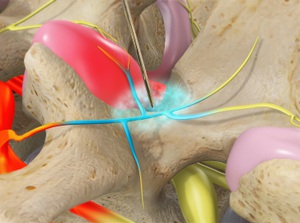Cervical Medial Branch Blocks
A Cervical Medial Branch Block is a diagnostic and therapeutic procedure used to relieve neck pain caused by inflammation or irritation of the medial branch nerves, which transmit pain signals from the facet joints in the cervical spine (neck) to the brain. This procedure involves injecting a small amount of anesthetic near the medial branch nerves to temporarily numb them, which helps determine if these nerves are the source of the pain. If successful, this procedure can provide temporary relief and serve as a precursor to a more long-lasting procedure, such as radiofrequency ablation.
Cervical Medial Branch Blocks can be utilized as a treatment for:
-Neck Pain
Cervical Medial Branch Blocks
A successful cervical medial branch block will provide temporary pain relief, typically lasting a few hours to several days, as the anesthetic wears off. The primary purpose of the procedure is diagnostic, helping the doctor confirm the source of pain. If the medial branch block is effective, it may indicate that a longer-lasting treatment, such as radiofrequency ablation, could be beneficial.
You might consider this procedure if:
Chronic Neck Pain: You experience ongoing neck pain that has not improved with conservative treatments like physical therapy, medications, or lifestyle changes.
Pain from Arthritis or Injury: Degenerative conditions like osteoarthritis or injuries, such as whiplash, are causing persistent pain in the cervical spine.
Diagnosing Pain Source: The doctor needs to identify if the medial branch nerves are the source of your neck pain before recommending further treatment.
Potential for Long-Lasting Relief:
You are exploring options for long-term pain relief and want to determine if radiofrequency ablation may be an appropriate follow-up treatment.
What to Expect for the Treatment?
A Cervical Medial Branch Block is generally performed on an outpatient basis and takes about 15 to 30 minutes. The procedure involves:
Preparation: The patient lies face-down, and the neck area is cleaned and sterilized. Local anesthesia is used to numb the skin and surrounding tissues.
Guidance with Fluoroscopy: Using fluoroscopy (X-ray guidance), the doctor precisely locates the medial branch nerves and guides the needle to the correct position.
Injection of Anesthetic:
A small amount of anesthetic, sometimes combined with a steroid, is injected near the medial branch nerves, temporarily numbing them.
Observation: After the injection, the patient is observed to see if the pain is reduced. If the pain relief is significant, it indicates that the medial branch nerves are likely the source of the pain.

Interested in our medical services? We’re here to help!
We want to know your needs exactly so that we can provide the perfect solution. Let us know what you want and we’ll do our best to help.
